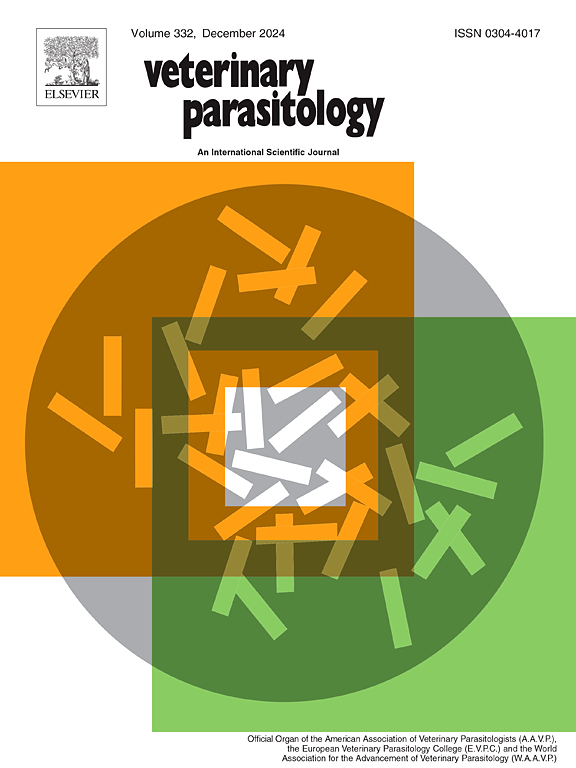安大略省羊群母羊及其后代唾液抗卡拉IgA水平及其与胃肠道寄生和后代生产性能的关系
IF 2.2
2区 农林科学
Q2 PARASITOLOGY
引用次数: 0
摘要
放牧羔羊对胃肠道线虫(GINs)产生免疫力的速度是高度可变的,取决于幼虫(L3)的挑战、营养、遗传和整体健康等因素。唾液免疫球蛋白A (IgA)抗碳水化合物幼虫抗原(CarLA),已被证明是绵羊对GINs免疫的一个指标。本研究旨在测量安大略省母羊及其后代唾液中抗卡拉IgA浓度(被认为是一种中等遗传特征),并研究其与放牧羔羊健康和生产性能的关系。2022年,在加拿大安大略省的第一个放牧季节之后,在繁殖之前,随机选择了98只母羊作为替代。选择时,测定每只母羊的唾液抗卡拉IgA浓度、粪卵数和体重。2023年,这些母羊在返回牧场4周后重新采样;同样,在放牧开始后60天,鉴定并取样了后代羔羊(n = 107)。抽样时,22.4% %(24/107)的后代羔羊可检测到唾液抗卡拉IgA。线性混合模型显示,在年龄和性别控制下,母鼠2022年唾液抗卡拉IgA浓度与子代体重呈正相关(β=0.834; = 0.008页)。此外,2023年白头羊唾液抗卡拉IgA浓度与放牧后代FEC呈负相关(β= - 0.191; = 0.044页)。这些数据表明,安大略省羔羊对GINs的获得性免疫发育较早,并且母羊唾液中抗卡拉IgA浓度可以预测后代在牧场上暴露于GINs时的生产性能。本文章由计算机程序翻译,如有差异,请以英文原文为准。
Salivary anti-CarLA IgA levels in ewes and their offspring and association with gastrointestinal parasitism and offspring performance in Ontario sheep flocks
The rate at which pastured lambs develop immunity to gastrointestinal nematodes (GINs) is highly variable and depends on factors such as larval (L3) challenge, nutrition, genetics and overall health. Salivary immunoglobulin A (IgA) against carbohydrate larval antigen (CarLA), found on the L3 epicuticle of GINs, has been shown to be an indicator of immunity to GINs in sheep. This study aimed to measure the salivary anti-CarLA IgA concentrations, considered a moderately heritable trait, of Ontario ewes and their offspring, and examine associations with the health and performance of pastured lambs. In 2022, 98 replacement ewe lambs were randomly selected in Ontario, Canada, following their first grazing season and just prior to breeding. At selection, each ewe lamb had its salivary anti-CarLA IgA concentration, fecal egg count (FEC), and weight measured. In 2023, these ewes were re-sampled 4 weeks after returning to pasture; likewise, offspring lambs (n = 107) were identified and sampled 60 days after grazing began. At sampling, 22.4 % (24/107) of offspring lambs had detectable salivary anti-CarLA IgA. Linear mixed models revealed that the 2022 salivary anti-CarLA IgA concentration in dams was positively associated with offspring weight, when age and sex were controlled (β=0.834; p = 0.008). Additionally, the 2023 salivary anti-CarLA IgA concentrations in dams were negatively associated with the FEC of their pastured offspring (β= −0.191; p = 0.044). These data suggest that acquired immunity to GINs develops early in Ontario lambs, and that salivary anti-CarLA IgA concentration of the dam may predict the performance of offspring when exposed to GINs on pasture.
求助全文
通过发布文献求助,成功后即可免费获取论文全文。
去求助
来源期刊

Veterinary parasitology
农林科学-寄生虫学
CiteScore
5.30
自引率
7.70%
发文量
126
审稿时长
36 days
期刊介绍:
The journal Veterinary Parasitology has an open access mirror journal,Veterinary Parasitology: X, sharing the same aims and scope, editorial team, submission system and rigorous peer review.
This journal is concerned with those aspects of helminthology, protozoology and entomology which are of interest to animal health investigators, veterinary practitioners and others with a special interest in parasitology. Papers of the highest quality dealing with all aspects of disease prevention, pathology, treatment, epidemiology, and control of parasites in all domesticated animals, fall within the scope of the journal. Papers of geographically limited (local) interest which are not of interest to an international audience will not be accepted. Authors who submit papers based on local data will need to indicate why their paper is relevant to a broader readership.
Parasitological studies on laboratory animals fall within the scope of the journal only if they provide a reasonably close model of a disease of domestic animals. Additionally the journal will consider papers relating to wildlife species where they may act as disease reservoirs to domestic animals, or as a zoonotic reservoir. Case studies considered to be unique or of specific interest to the journal, will also be considered on occasions at the Editors'' discretion. Papers dealing exclusively with the taxonomy of parasites do not fall within the scope of the journal.
 求助内容:
求助内容: 应助结果提醒方式:
应助结果提醒方式:


